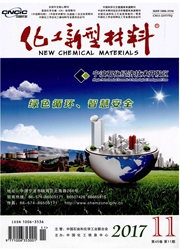

 中文摘要:
中文摘要:
有机硅改性聚氨酯是一类发展迅速的多功能高分子材料,在生物以及防污涂层等技术领域具有广泛的用途。由于硅氧烷与聚氨酯链段之间溶解度参数的巨大差距,使得此类聚合物通常能够形成不同尺度的多相结构,而其性能也在很大程度上依赖于相分离尺度。因此研究其相分离与分子结构之间的关系就变得十分必要,近年来更是受到了广大研究者的重点关注。对近期该类聚合物微相分离的研究进行了综述,从聚氨酯的结构出发,阐述了有机硅改性聚氨酯之所以产生微相分离的原因,并从其物理化学原理解释影响其相分离的各种因素,总结了软段与硬段两方面各种因素对有机硅改性聚氨酯微相分离的影响,以期对今后硅氧烷改性聚氨酯类聚合物的分子设计起到指导作用。
 英文摘要:
英文摘要:
Polysiloxane modified polyurethane have been widely used in anti-fouling coatings,bio-compatible materials and other fields.The solubility parameters between polysiloxane and polyurethane are so different that the copolymers combined by the two form complicated structures with various scales.While the properties are due to rely on the scales.Hence,the relationship between microphase separation and molecular structure has become one of the hottest issues.This paper presented the reasonable explanations of phase separation among the structure of polyurethane.Subsequently the various impacts of phase separation were explained from the aspect of physicochemical principles.The influence factors on microphase separation of polyurethane were finally reviewed,including type,concentration and molecular weight of soft segment,as well as composition structure,concentration and length of hard segment.
 同期刊论文项目
同期刊论文项目
 同项目期刊论文
同项目期刊论文
 Synthesis of non-collapsed hollow polymeric nanoparticles with shell thickness on the order of polym
Synthesis of non-collapsed hollow polymeric nanoparticles with shell thickness on the order of polym Ab Initio Batch Emulsion RAFT Polymerization of Styrene Mediated by Poly(acrylic acid-b-styrene) Tri
Ab Initio Batch Emulsion RAFT Polymerization of Styrene Mediated by Poly(acrylic acid-b-styrene) Tri Styrene–Butadiene–Styrene Triblock Copolymer Latex via Reversible Addition–Fragmentation Chain Trans
Styrene–Butadiene–Styrene Triblock Copolymer Latex via Reversible Addition–Fragmentation Chain Trans Synthesis of structured nanoparticles of styrene/butadiene block copolymers via RAFT seeded emulsion
Synthesis of structured nanoparticles of styrene/butadiene block copolymers via RAFT seeded emulsion Polystyrene-block-poly(n-butyl acrylate)-block-polystyrene Triblock Copolymer Thermoplastic Elastome
Polystyrene-block-poly(n-butyl acrylate)-block-polystyrene Triblock Copolymer Thermoplastic Elastome Facile Synthesis of Nanocapsules and Hollow Nanoparticles Consisting of Fluorinated Polymer Shells b
Facile Synthesis of Nanocapsules and Hollow Nanoparticles Consisting of Fluorinated Polymer Shells b Structure and surface properties of polyacrylates with short fluorocarbon side chain: Role of the ma
Structure and surface properties of polyacrylates with short fluorocarbon side chain: Role of the ma Synthesis of triblock copolymer having alternating structures and kinetics study on RAFT-mediated bu
Synthesis of triblock copolymer having alternating structures and kinetics study on RAFT-mediated bu Fabrication of non-collapsed hollow polymeric nanoparticles with shell thickness in the order of ten
Fabrication of non-collapsed hollow polymeric nanoparticles with shell thickness in the order of ten Effect of monomer composition on apparent chain transfer coefficient in reversible addition fragment
Effect of monomer composition on apparent chain transfer coefficient in reversible addition fragment Model-based design and synthesis of gradient MMA/tBMA copolymers by computer-programmed semibatch at
Model-based design and synthesis of gradient MMA/tBMA copolymers by computer-programmed semibatch at In situ miniemulsion polymerization for waterborne polyurethanes: Kinetics and modeling of interfaci
In situ miniemulsion polymerization for waterborne polyurethanes: Kinetics and modeling of interfaci 期刊信息
期刊信息
